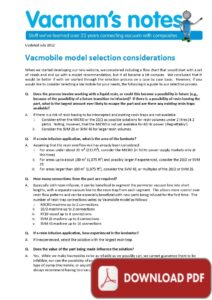When we started developing this website, we considered including a flow chart that would start with a set of needs and end up with a model recommendation, but it all became a bit complex. We concluded that it would be better if with we worked through the selection process on a case by case basis. However, if you would like to consider selecting a Vacmobile for your needs, the following is a guide to our selection process.
Q. Does the process involve working with a liquid resin, or could this become a possibility in future (e.g. because of the possibility of a future transition to infusion)? If there is a possibility of resin leaving the part, what is the largest amount ever likely to escape the part and are there any existing resin traps available?
A. If there is a risk of resin having to be intercepted and existing resin traps are not available:
- Consider the E1 system for resin volumes under 0.6 litre (20 fluid oz)
- Consider either the MICRO or the 20/2 as possible solutions for resin volumes under 2 litres (4.2 pints). Noting, however, that the MICRO is not available for 60 Hz power.
- Consider the E12 or Modular 2S for resin volumes up to 12 litres (3.1 US gallons)
- Consider a twin trap version of the Modular 4S for resin volumes up to 24 litres (6.2 US gallons).
Q. If a resin infusion application, what is the area of the laminate?
A. Assuming that the resin overflow risk has already been considered:
- For areas under about 20 m2 (215 ft2), consider the E1 or MICRO 8/2 system (MICRO only available for 230 V/50Hz power)
- For areas up to about 100 m2 (1,075 ft2) and possibly larger if experienced, consider the 20/2 or Modular 2S
- For areas larger than 100 m2 (1,075 ft2), consider the Modular 4S, or multiples of the 20/2 or Modular 2S.
Q. How many connections from the part are required?
A. Especially with resin infusion, it can be beneficial to segment the perimeter vacuum line into short lengths, with a separate vacuum line to the resin trap from each segment. This allows more control over resin flow patterns and can be especially beneficial with new parts being infused for the first time. The number of resin trap connections varies by Vacmobile model as follows:
- RT1 & RT2 resin traps – up to 2 connections
- E1, MICRO & 20/2 systems – up to 2 connections
- RT19 resin trap – up to 8 connections
- Modular 2S system – up to 8 connections
- Modular 4S machine – up to 16 connections
Q. If a resin infusion application, how experienced is the laminator?
A. If inexperienced, select the solution with the largest resin trap.
Q. Does the value of the part being made influence the solution?
A. Yes. While we make Vacmobiles to be as reliable as we possibly can, we cannot guarantee them to be infallible, nor can the possibility of an operator mistake or a power failure be excluded. Regardless of the type of pump (Vacmobile, or any other), if the part value is high in relation to the equipment cost, we always recommend having two vacuum systems and a back-up power generator available.
Q. Is there lots of variability in the intended use? I.e. a variety of small parts being made much of the time, and large parts occasionally? (As can happen in boat building.)
A. Where there is lots of work variability, opt for multiple small machines rather than a single large one. Multiple small machines can always be combined to evacuate a large part and easily moved to other locations for making small parts. Consider multiples of any system model.
Q. Is it a teaching/training application?
A. In 50 Hz power countries consider the E1-8, or the MICRO 8/2, as the 8 m3/h capacity pump is very quiet, while providing all the features of the larger machines. Where pump noise is not the key consideration consider the Modular 2S, as this is an extremely versatile training machine.
Q. Are two separately controllable vacuum levels required, e.g., for RTM Light or double bagging?
A. Depending on other possible applications for the same machine:
- If the parts being made are smaller than about 4 m2 (40 ft2) and high production rates are not required, consider the 20/2 machine with Dual-Vac accessory
- If the parts being made are larger than about 4 m2 (40 ft2), or high production rates are required and if the machine is required exclusively for dual vacuum operation in the same location, consider the Modular 4S
- If the dual vacuum requirement is only occasional in a production, research or training application consider getting a pair of the appropriate single level models. Bring the machines together for the occasional dual vacuum work and use them separately for vacuum bagging or infusion for the remainder of the time.
Q. Is it necessary to infuse with degassed resin?
A. If the amount of resin involved per batch is less than about 10 litres (2.6 US gallons) consider using an RT19 fitted with the degas-on-the-way- in accessory as the degassing vessel (either separately or as part of an Modular 2S) and any other model for the infusion part of the process. If a process being used all the time, consider the Modular 4S (which can function as 2 independent systems).
While we hope this note will be helpful, never hesitate to explain your particular requirements to us and let us select the optimum model or combination of models to suit your needs.
Feedback or queries on this note?
We are keen to improve the accuracy and value of Vacman’s Notes. If you have any feedback or queries regarding this note, or would like to suggest new topics to be covered, Vacman would be pleased to hear from you! Please comment below! Or email [email protected]

